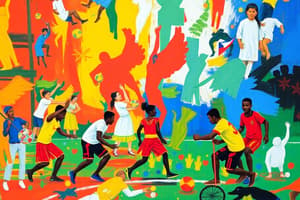Podcast
Questions and Answers
What aspect of Spanish culture is evident in games like Piko?
What aspect of Spanish culture is evident in games like Piko?
- The rules and structure of children's games (correct)
- The use of foreign materials
- The emphasis on physical health
- The focus on competitive play for adults
How did Filipinos adapt American influences in recreational games?
How did Filipinos adapt American influences in recreational games?
- By introducing individualistic play focused on personal achievement
- By establishing rigid rules for competitive play
- By creating hybrid games that mix foreign and local elements (correct)
- By completely discarding traditional games
What is a characteristic of Tumbang Preso?
What is a characteristic of Tumbang Preso?
- It has no fixed rules
- It requires a ball to play
- It involves knocking down a can using a slipper (correct)
- It is played exclusively indoors
What is the primary purpose of recreational games?
What is the primary purpose of recreational games?
What role do traditional and recreational games play in cultural preservation?
What role do traditional and recreational games play in cultural preservation?
Which of the following benefits is primarily associated with traditional games for children?
Which of the following benefits is primarily associated with traditional games for children?
Which characteristic is NOT associated with traditional games?
Which characteristic is NOT associated with traditional games?
In what way do traditional games contribute to mental development?
In what way do traditional games contribute to mental development?
How do traditional games reflect the communities they come from?
How do traditional games reflect the communities they come from?
How do traditional games promote emotional well-being?
How do traditional games promote emotional well-being?
What element did the Spanish colonization contribute to Philippine games?
What element did the Spanish colonization contribute to Philippine games?
What is a key feature of recreational games?
What is a key feature of recreational games?
What makes traditional and recreational games inclusive?
What makes traditional and recreational games inclusive?
Which are common characteristics of traditional games?
Which are common characteristics of traditional games?
Why do traditional games hold historical significance?
Why do traditional games hold historical significance?
What is a shared benefit of participating in both traditional and recreational games?
What is a shared benefit of participating in both traditional and recreational games?
Flashcards are hidden until you start studying
Study Notes
Traditional vs. Recreational Games
- Traditional games have cultural roots, transmitted through generations, linked to social structures, and community practices.
- Recreational games prioritize enjoyment, relaxation, and leisure, allowing informal organization for diverse age and skill levels.
Key Characteristics
- Traditional games emphasize cultural heritage, accessibility, and physical/mental skills while fostering social interactions.
- Recreational games focus on leisure, social engagement, physical and mental activity, inclusivity, and flexibility in gameplay.
Cultural Significance
- Philippine traditional and recreational games reflect Filipino creativity, values, and social interactions, promoting teamwork and skill-building.
- Typically played in open spaces with minimal materials, these games celebrate simple, shared experiences across communities.
Origins and Influences
- Indigenous games emerged from pre-colonial practices, linked to daily activities, rituals, and social gatherings, embodying communal living and strategic thinking.
- Spanish colonialism introduced new cultural elements, integrating them into local games, seen in variations like Piko, influenced by Spanish children's games.
- The American colonial period diversified recreational activities, as Western sports were adapted into hybrid games, exemplified by Sipa, a localized kicking game.
Local Adaptation and Evolution
- Filipino ingenuity led to games designed with locally available materials; Tumbang Preso features slipper use to knock down a can.
- Oral traditions preserve game rules and styles, which may vary by region, showcasing the local adaptations of these engaging activities.
Importance of Traditional and Recreational Games
- Cultural preservation occurs through teaching and playing games, connecting communities to their roots and preserving traditional knowledge.
- Games foster social bonding, teamwork, and a sense of belonging, promoting unity within communities.
- Engaging in these activities supports physical fitness and health, particularly beneficial for children, encouraging an active lifestyle.
- Cognitive skills are honed through strategy and problem-solving, enhancing attributes like memory and critical thinking.
- These games provide emotional relief from routine, boosting mood and reducing anxiety, aiding overall mental well-being.
- Inclusivity is a core feature, allowing participation across ages and backgrounds, with adaptable formats catering to diverse needs.
- Learning valuable life skills such as perseverance, patience, and teamwork is integral to the experience of both traditional and recreational games.
Studying That Suits You
Use AI to generate personalized quizzes and flashcards to suit your learning preferences.




